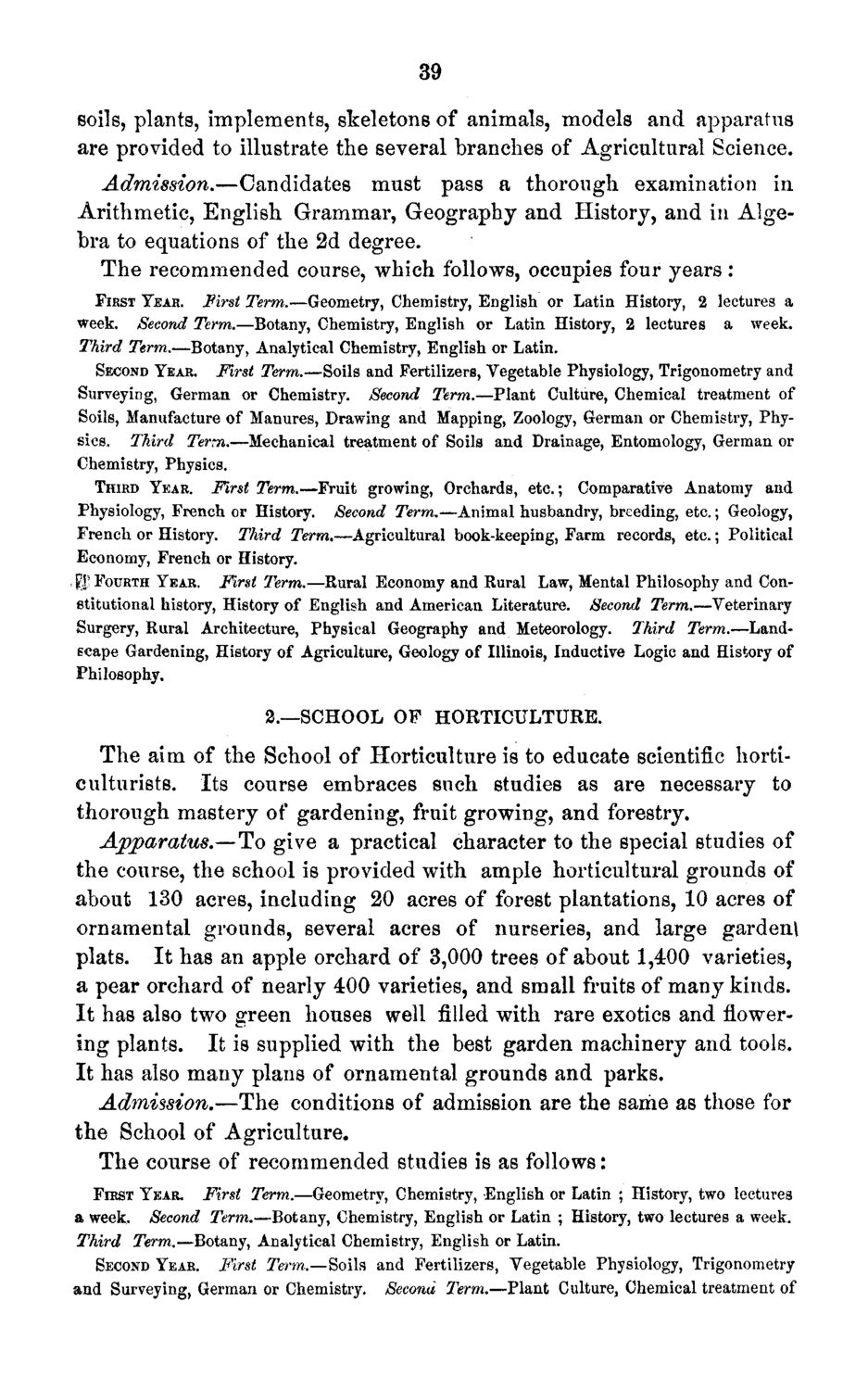| |
| |
Caption: Board of Trustees Minutes - 1871
This is a reduced-resolution page image for fast online browsing.

EXTRACTED TEXT FROM PAGE:
39 soils, plants, implements, skeletons of animals, models and apparatus are provided to illustrate the several branches of Agricultural Science. Admission.—Candidates must pass a thorough examination in Arithmetic, English Grammar, Geography and History, and in Algebra to equations of the 2d degree. The recommended course, which follows, occupies four years: FIRST YEAR. First Term.—Geometry, Chemistry, English or Latin History, 2 lectures a week. Second Term.—Botany, Chemistry, English or Latin History, 2 lectures a week. Third Term.—Botany, Analytical Chemistry, English or Latin. SECOND YEAR. First Term.—Soils and Fertilizers, Vegetable Physiology, Trigonometry and Surveying, German or Chemistry. Second Term.—Plant Culture, Chemical treatment of Soils, Manufacture of Manures, Drawing and Mapping, Zoology, German or Chemistry, Physics. Third Term.—Mechanical treatment of Soils and Drainage, Entomology, German or Chemistry, Physics. THIRD YEAR. First Term.—Fruit growing, Orchards, etc.; Comparative Anatomy and Physiology, French or History. Second Term.—Animal husbandry, breeding, etc.; Geology, French or History. Third Term,—Agricultural book-keeping, Farm records, etc.; Political Economy, French or History. .gT FOURTH YEAR. First Term.—Rural Economy and Rural Law, Mental Philosophy and Constitutional history, History of English and American Literature. Second Term.—Veterinary Surgery, Rural Architecture, Physical Geography and Meteorology. Third Term.—Landscape Gardening, History of Agriculture, Geology of Illinois, Inductive Logic and History of Philosophy. 2.—SCHOOL OF HORTICULTURE. The aim of the School of Horticulture is to educate scientific horticulturists. Its course embraces such studies as are necessary to thorough mastery of gardening, fruit growing, and forestry. Apparatus.—To give a practical character to the special studies of the course, the school is provided with ample horticultural grounds of about 130 acres, including 20 acres of forest plantations, 10 acres of ornamental grounds, several acres of nurseries, and large garden! plats. It has an apple orchard of 3,000 trees of about 1,400 varieties, a pear orchard of nearly 400 varieties, and small fruits of many kinds. It has also two green houses well filled with rare exotics and flowering plants. It is supplied with the best garden machinery and tools. It has also many plans of ornamental grounds and parks. Admission.—The conditions of admission are the same as those for the School of Agriculture. The course of recommended studies is as follows: FIRST YEAR, First Term.—Geometry, Chemistry, English or Latin ; History, two lectures a week. Second Term.—Botany, Chemistry, English or Latin ; History, two lectures a week. Third Term.—Botany, Analytical Chemistry, English or Latin. SECOND YEAR. First Term.—Soils and Fertilizers, Vegetable Physiology, Trigonometry and Surveying, German or Chemistry. Second Term.—Plant Culture, Chemical treatment of
| |